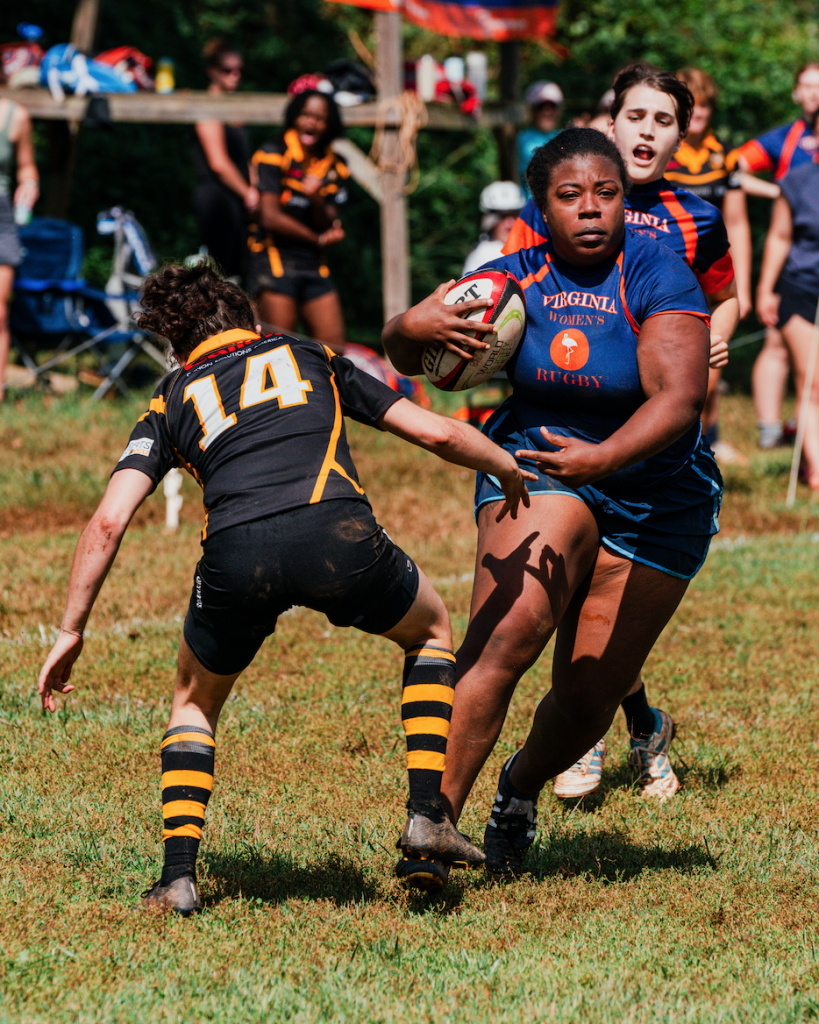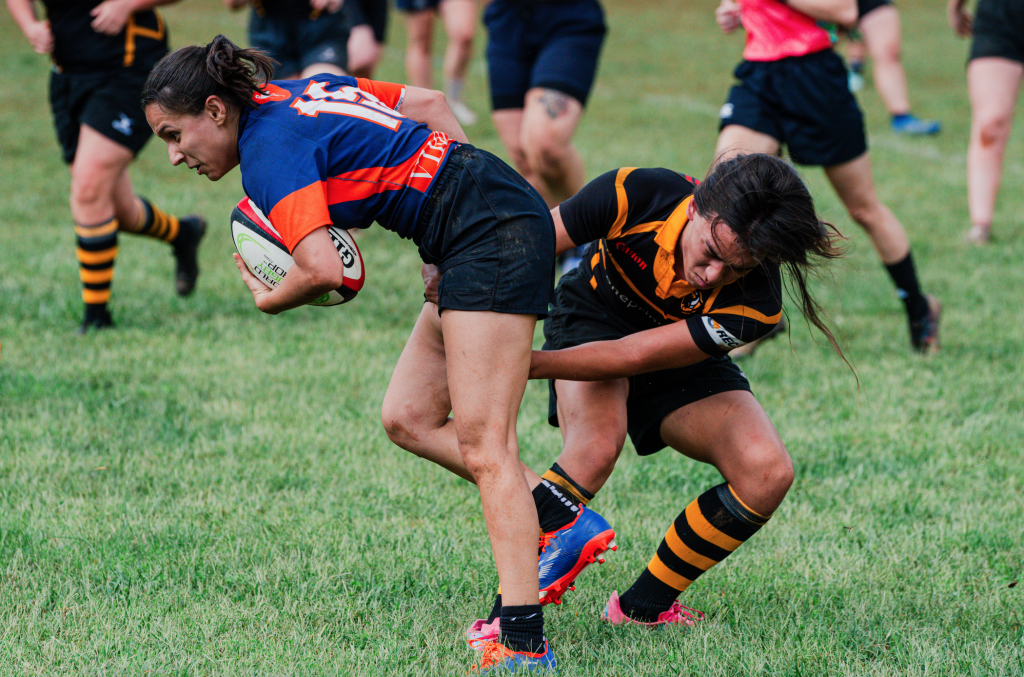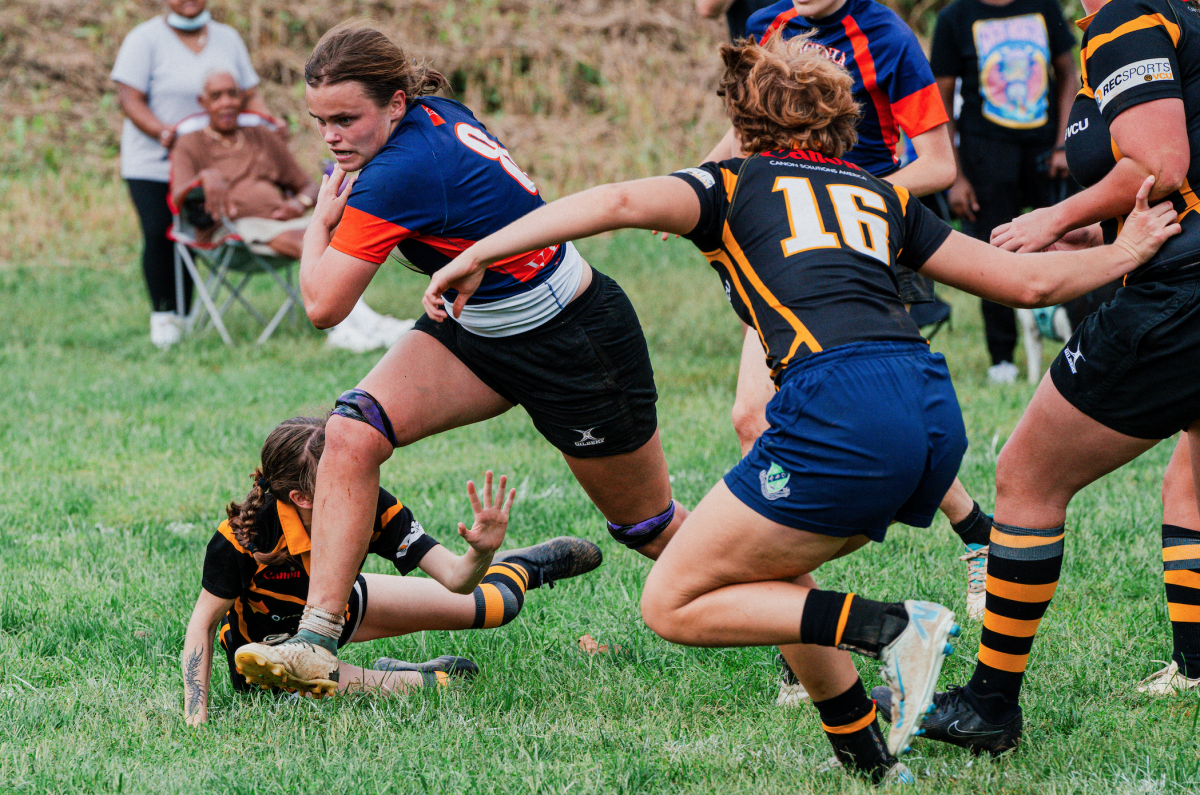It’s late afternoon on a soccer field, at the tail end of summer. The sinking sun is casting long shadows, and the last of the mosquitoes are homing in on anything with blood. But the women on the field don’t notice the little buzzers; they’re concentrating on their drills.
Running, passing, tackling—but this game is played with a ball shaped like a honeydew melon, and passing is two-handed, underhand, always backward. To tackle, two arms full-body grab the ball carrier. The women also practice binding (a following teammate leans a shoulder into the ball-carrier’s hip) to drive through an opponent. Then three players use these skills to get around two opponents. “Call for the ball! Talk to each other!” yells Coach Clare O’Reilly. Water break, and some work on ruck skills before actual playing time.
No, you are not in Australia. This is Charlottesville, and you’re watching the Blue Ridge Bears, our local women’s rugby club.
Women’s rugby is having a big moment. If you paid attention to the Paris Olympics, you likely heard about the American women’s rugby sevens team beating powerhouse Australia to win bronze, with a heart-stopping last-minute full-field run to goal by center Alex Sedrick. And you probably saw a host of social media posts from Team USA’s center Ilona Maher promoting rugby, strong women, and body positivity. Not many women’s rugby players have been contestants on “Dancing With the Stars,” or cover models for Sports Illustrated’s Swimsuit Issue, but Maher has the attitude—and the killer red lipstick—to pull it off.
“As soon as the Olympics started, our email blew up,” says Blue Ridge Bears Club Administrator Angela Sorrentino. “We got a huge influx of players—we have from 20 to 30 members now.”

But it’s not just Maher and the medal. Rugby, and women’s rugby in particular, has been among the fastest-growing sports for the last decade, both in the USA and worldwide. In 2019, World Rugby launched a global campaign promoting young female players as “Unstoppables,” and developed a toolkit called Try and Stop Us to help clubs drive recruitment. As of last year, according to World Rugby, the number of active registered female players increased by 34 percent, to just under 320,000; the number of female participants (someone who has tried rugby in school programs or clubs) grew by 52 percent, to more than 1.3 million young women and girls.
In the U.S., the growth of collegiate women’s rugby in the 1970s (helped by Title IX) led to the formation of a U.S. national team in 1987. Nicknamed the Eagles, the team won the inaugural 1991 Women’s World Cup, and finished second in the two subsequent World Cups. More recently, high-profile events like the Olympics have helped drive interest in the sport.
Another factor has been the increasing sense of empowerment among young girls and women—the feeling that they can be big, strong, athletic, and at home with it. UVA women’s rugby Head Coach Nancy Kechner, who began playing rugby at UVA and has been a volunteer coach for the club there for 27 years, calls it “the most empowering sport for women.”
“Its rules are exactly the same as for the men’s game,” she says. “It’s for women who want to do something different, and challenge themselves. This game is all about flow, about moving as one, and there’s a lot of decision-making on the fly.”
What draws players to the Bears, Sorrentino says, is the opportunity to keep playing a team sport into their post-academic lives. “It may seem kind of crazy to start with rugby—there’s a lot of misconceptions about it. But for rugby, physical attributes don’t really matter. Small players can be fast, and really good at tackling; some large players may think they can’t run, but there’s a place for everyone.”
No question, though, that rugby is a contact sport. O’Reilly stresses that many of the drills, and the laws (rugby has laws instead of rules, she says, because they are “open to interpretation”) are focused on safety. Tackling a ball player above the sternum, or shoving instead of grabbing with the arm, is a penalty. And there is no blocking or running interference like there is in football. Kechner, who has coached O’Reilly and several other Bears players, says rugby is about “contact, not collision.”

For many players, rugby’s free-form nature is part of its appeal. Teams can play on a football field or soccer pitch, and there’s no special equipment beyond a mouth guard, cleats, and maybe a scrum cap. There are two versions: rugby sevens (seven on a side, playing seven-minute halves) and rugby 15s (15 on a side, playing 40-minute halves). Players are basically forwards or backs—with some interesting specialty names like scrum-half, hooker, and loosehead or tighthead props—but there’s no hierarchy, and any player can score. The ball is always in play, and the game only stops for penalties, out of bounds, and serious injuries—after which most players get bandaged up and go back in.
O’Reilly is a case in point. On the evening that I observe practice, she has an inch or so of stitches near her eye. “Yeah, I got injured,” she says, no big deal—apparently her eye and a teammate’s hand ended up near the ball at the same time. But none of the women at practice seem too worried about injuries.
The team is a real mix. Almost everyone here tonight has participated in sports for most of their lives, but only seven have played rugby before, four of them at UVA. They range in age from early 20s to early 50s, from tall to short, from thin to stocky. There are plenty of tattoos and a good bit of brightly dyed hair, and T-shirts ranging from “Ireland Rugby” and “Cape Fear Sevens” to “Queen City Unity” (a Staunton-based nonprofit) and “National Geographic.”
Bears player Kelly Graves, 22, participated in a range of sports in high school: cross country, track, softball. She started playing rugby at Christopher Newport University. “My sister played rugby, and I wanted to try it, but CNU didn’t have a women’s rugby team until my sophomore year,” she recalls. When she moved to Charlottesville after graduating last December, she was happy to find the Bears. “This is the most inclusive sport,” Graves says enthusiastically. “There’s a place for everybody, literally. You need sprinters, you need tacklers. Taller people can be harder to tackle, and playing the sidelines you need to be faster.”
Saoirse Teevan-Kamhawi, 23, grew up participating in tennis, karate, and rowing, and when she came to UVA, a colleague in her running club got Teevan-Kamhawi into rugby. She’s now working in Harrisonburg, where there’s no rugby club, so she was excited to find the Bears. “It’s a great group,” she says. “People who play rugby are just the nicest; they’re easy to be around. In rugby, you have to be willing to look a little silly and fall on your face sometimes—and we teach people how to fall. But you also have to be willing to put your heart into it. The whole game is about supporting your fellow players.”
Courtney Russ, 37, is a little older than her club mates but found the Bears for similar reasons. An athlete all through school—soccer in high school, field hockey in college—she says she “was looking for a team sport, and found this team just before the [August] call for new players. I’m new to Charlottesville, and was looking for a way to meet people.” (The group makes an effort to socialize—beers, bowling, group workouts.) As a beginning player, Russ appreciates O’Reilly and fellow coach Taylor Torro focusing on skill development: “They’re good about pairing a new person with a veteran.” The best part? “Rugby is a different way to use your body. Everyone finds a way to feel powerful and strong.”

That’s the goal of another recent recruit, Jen Truslow. At 53, she is the oldest Bear, but she’s not new to rugby. She was a high school exchange student in Australia, and learned Aussie rules rugby there, but when she came back to the United States, there was nowhere to play. “When I was a kid, women’s sports were second-tier,” she recalls. “No one encouraged me, girls weren’t trained to be aggressive.” But she kept her interest in the game, and after a recent weight loss, “I was feeling good and decided to try it—I’m not getting any younger—and these women have been kind and welcoming,” Truslow says, as she heads out for more drills after the water break. “And I’m pretty tough!”
Some athletes who started playing rugby in college found other college sports too competitive—meaning it was hard to get on a team because there were so many skilled players that coaches could afford to make cuts. After college, outlets are limited, especially for team sports. And full-time employment doesn’t leave a lot of hours for athletics. But all these women want to stay active, and enjoy the social interaction of being on a team. The club welcomes all comers 18 years and older. There’s a rookie skills clinic every month, and no one gets cut.
Sorrentino, who started playing rugby in 2017 at college in upstate New York, came to Charlottesville in 2021 for an internship at UVA (she’s a pediatric dietitian). She decided to stay, and began looking for a rugby club. At that point, just after the pandemic, the Bears were inactive, and Sorrentino took on reviving the club. Last year, she recruited another player to be social media director. As of this year, the Bears are an official nonprofit, and players will start paying dues to support the outfit.
The Virginia Rugby Football Club, Charlottesville’s men’s rugby group—founded in the 1960s, it’s “the oldest rugby club south of the Mason-Dixon line,” according to its Facebook page—has been supportive, Sorrentino says,
“When we were getting started, they invited us over to practice with them, which was nice but a little intimidating,” she says. The Bears now use the same practice field as VRFC, behind the Veterans of Foreign Wars Post 1827, two evenings a week.
The Bears are still in the building phase, as are other clubs in the region. The group schedules scrimmages and friendly games with the women’s teams from UVA and Virginia Commonwealth University, as well as clubs from Richmond and Raleigh, North Carolina. They also play in local tournaments—the Cville Sevens last June, and the Christmas Sevens tournament in Glen Allen. O’Reilly is excited because the influx of players means the Bears may be able to field a team to play rugby 15s next year.
New players are always welcome to come out for the monthly skills session—if you’d rather watch than play, fans are welcome too. And get ready: March 2025 will see the launch of Women’s Elite Rugby, the first U.S. professional women’s rugby league, followed by the Women’s Rugby World Cup in England in August. In the meantime, Sorrentino is looking for a few good Bears sponsors. Consider having your organization’s logo on the backs of these strong women. As Kechner said about Ilona Maher, “She’s a great role model—one big gorgeous badass!”
